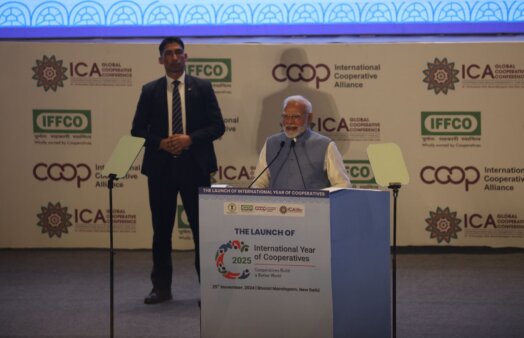18 June 2024
- Top 100 boost revenue to $43.2 billion
- Health insurance, agribusiness and motoring services shine
- Profitability returns after shaking off COVID-19 impacts
Australia’s Top 100 co-operative and mutual businesses posted a record performance in the 2023 financial year, defying domestic and international headwinds to grow total revenue by 16.1 per cent to $43.2 billion.
The latest National Mutual Economy (NME) report, published today by the Business Council of Co-operatives and Mutuals (BCCM), showed strong revenue growth across most parts of the sector despite global inflationary pressures.
The report also showed a dramatic return to profitability for the sector with the Top 100 posting a combined net profit of $1.83 billion, more than double the previous year’s $712 million.
The strong earnings turnaround reflected an improved performance by co-ops and mutuals operating in health insurance, agribusiness and motoring services, while those in financial services were impacted by the higher interest rate environment which dampened consumer borrowing.
The Top 100 list features some of Australia’s biggest unlisted companies including West Australian grain handler CBH, health insurers HCF and HBF, motoring groups NRMA, RACQ and RAA as well as dairy producer Norco.
The Chief Executive Officer of the BCCM, Melina Morrison, said the strong financial performance during a period of economic instability demonstrated the resilience of the sector and underlined the competitive advantages of its business purpose.
“The fact that revenue continues to grow, despite volatile economic circumstances for those who sell their goods overseas, or in competitive markets, shows co-ops and mutuals proudly hold their own year in, year out, when the spotlight is focussed on better known but not necessarily more successful listed companies.
“The NME report is a valuable snapshot of the diverse industry and commercial success of BCCM members who accept the need to make a profit for sustainability and growth but place more value in the provision of services to their customers who are also their owner members.”
Co-operatives and mutuals exist for the benefit of their members, which may be customers, staff, suppliers, or a combination of stakeholders. Unlike listed companies, they are not motivated by the need to maximise profits and pay dividends to investors. Instead, they can use surplus funds to reinvest in services and deliver benefits to members. Eight in every 10 Australians are members of at least one co-operative or mutual.
“In periods of high inflation, co-ops and mutuals are better able to counter headwinds because they keep their operating costs lean and do what they can to reinvest in their businesses and people,” Ms Morrison said.
“Time and time again we have seen co-ops and mutuals doing the heavy lifting in our economy by ensuring Australians have access to the services and products they need, regardless of where they live, whether that is important food staples, affordable housing, or banking services.
“This is why we are continuing to work Government on an enabling operating environment for co-ops and mutuals to ensure they can continue to participate in an ever more competitive business landscape.
“The recent decision by Fonterra to sell its Australian dairy assets, which would leave Norco as the only large producer owned dairy producer, illustrates the important role that co-operatives play in ensuring food security.
“Co-ops and mutuals have shown that they can be globally competitive while ensuring profits and value remain in the domestic agriculture sector as well as shoring up supply chains.”
Top 10 CME by turnover in FY2022-23
- CBH, WA, $6.19 billion
- HCF, NSW, $3.9 billion
- Capricorn Society, WA, $3.4 billion
- RACQ, QLD, $2.39 billion
- HBF Health, WA, $2.06 billion
- Australian Unity, VIC, $1.86 billion
- RAC, WA, $1.40 billion
- Teachers Health, NSW, $939 million
- NRMA, NSW, $826 million
- RACV, VIC, $825 million
The NME report shows that Australia’s co-ops and mutuals had combined active memberships of 34.7 million during the 2023 financial year, up from a previous 33.3 million.
This was despite the number of co-ops and mutuals falling slightly to 1819, (1848 previously), partly reflecting merger activity within the sector.
“It is notable that at a time when households are feeling the pressure, membership of co-ops and mutuals continued to grow, an endorsement of the value they deliver in good times and bad,” Ms Morrison said.
Jobs growth in the sector was also strong, with co-operatives and mutuals employing 89,000 people, up from 76,000 in the previous year.
CBH held onto its spot as the largest member owned business, with turnover of $6.19 billion, slightly down on the previous year’s $6.23 billion. It was followed by health insurer HCF ($3.9 billion), automotive group Capricorn Society ($3.4 billion) and Queensland’s RACQ ($2.39 billion).
Agribusinesses benefited from strong commodity prices, which were partly offset by higher input costs. Although much of the supply chain disruption caused by COVID-19 had abated, the sector continued to feel the impact of the war in Ukraine.
Media enquiries: Sue Frost, P&L Corporate Communications 0409 718 572
More information
- Explore the 2024 NME Report online
- Download the 2024 NME Report including Top 100 Co-operatives and Mutuals and expanded league tables
- Share the 2024 NME Report with your members: LinkedIn, X, Facebook, YouTube, online


